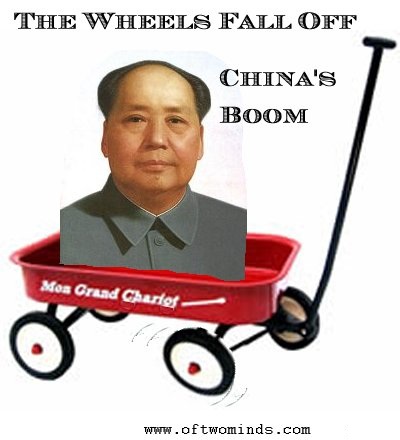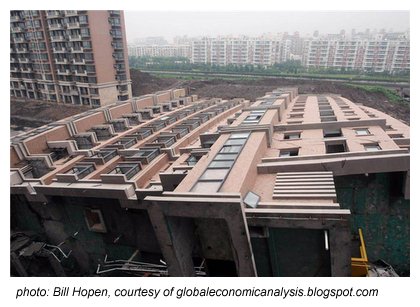Two Powder Kegs Ready to Blow: China & India
China and India are both powder kegs awaiting a spark for the same reason: systemic corruption.

The conventional view of China and India sports not one but two pair of rose-colored glasses: Chindia (even the portmanteau word is chirpy) is the world's engine of growth, and this rapid economic growth is chipping away at structural political and social problems.
Nice, especially from a distance. But on the ground, China and India (not Chindia--there is no such entity) are both powder kegs awaiting a spark for the same reason: systemic corruption in every nook and cranny of both nations. The conventional rose-colored view is that corruption will inevitably decline with modernization and economic growth.
This is simply wrong on multiple levels: as the opportunities for crony/neofeudal skimming increase, so does corruption. As the scale of the economy increases, so does the scale of corruption.
China's "princelings" (offspring and family of the inner political circle and top apparatchiks of the Communist Party) are billionaires, not mere millionaires. A recent expose of offshore accounts held by various Chinese billionaires estimated the wealth skimmed and transferred our of China at between $1 trillion and $4 trillion: China's Epic Offshore Wealth Revealed: How Chinese Oligarchs Quietly Parked Up To $4 Trillion In The Caribbean.
Even the top number is a gross underestimate, as $4 trillion only accounts for the skim of the top layer; beneath that 1/10th of 1% is the rest of the top 1%, tens of thousands of lower-level political functionaries who skimmed billions of dollars forcing peasants off their land and selling development rights to crony developers--to name but one common skim of many.
A more realistic estimate might be $6 trillion--half of China's gross domestic product (GDP). Consider the ramifications of the many models of systemic corruption at the top: How a PLA General Built a Web of Corruption to Amass a Fortune.
I know from confidential on-the-ground sources that a significant percentage of the entire top political layer of 3rd, 4th and 5th tier cities have left China for well-padded nests in the West: Australia and Canada are popular choices, as the right to immigrate can be purchased--just bring in the requisite sum of cash looted from peasants. (The U.S. also grants special immigration status to those bringing in major capital and declaring their intent to hire Americans: easy enough with looted millions.)
(Sidebar on how even the lowly functionary skimmer can get huge sums out of China: take a "vacation" to Macau. Buy $1 million in casino chips with your looted yuan. Lose $50,000 at the tables and then go cash in your remaining chips in U.S. dollars. Deposit the dollars in a Hong Kong or other Asian bank and then transfer the cash to L.A. or Vancouver to buy a house for cash. Repeat as necessary.)
All this systemic corruption is accepted as long as the conveyor belt of wealth is moving: that the previous political Plutocracy skimmed their $4 trillion and absconded with their ill-gotten gains is OK to their replacements, as long as there is another $6 trillion to be skimmed.
The problem is there isn't another $6 trillion to be skimmed. It has taken an enormous credit bubble of $23 trillion (The $23 Trillion Credit Bubble In China Is Starting To Collapse – What Next?) plus the monumental credit expansion of the shadow banking system in China to enable the skimming of $6 trillion by the political/financial Plutocracy.
This $23 trillion credit bubble is roughly twice the size of China's entire GDP ($12 trillion). That this credit bubble is generating less return in the real economy is obvious--diminishing returns have set in with a vengeance.
The revolution never starts with the oppressed peasantry--it starts with the bourgeois who bought the fantasy of another $6 trillion to be skimmed and credit bubbles/ real estate valuations that never go down. The leadership in China has managed to create a propaganda bubble of epic proportions: Chinese leaders are supposed to have a long-term view that puts the West to shame.
Alas, the secret view of China's leadership is considerably shorter-term: U.S. dollars in Swiss bank accounts, real estate in Vancouver, San Francisco, New York City, London, Geneva, etc. and whatever other assets can be scooped up with looted billions.
Corruption isn't just abstract: Much of China's building boom will not last a generation, much less a long-term timeline. This toppled tower is an apt metaphor for China's financialized crony-capitalist credit bubble and its shoddy corruption-riddled construction:

Nine held over Shanghai building collapse
The Chinese authorities are holding nine people in connection with the collapse of a 13-storey block of flats, raising fresh questions about corruption and shoddy practices in China's construction industry.
China's Towers and U.S. McMansions: When Things Fall Apart (Literally) (April 14, 2010).
India's system is different, but equally corrupt. Combine feudalism and religious tradition with a helping of modern crony capitalism and neofeudal looting, add a dash of post-Imperial flavoring and voila, corruption on every level.
The sad irony of this pervasive, systemic corruption that enriches the Plutocracy is that the average Indian and Chinese citizen is basically honest. Non-Elites will tolerate the corruption at the top as long as they believe their own prosperity is advancing. Once it becomes clear that their prosperity has been hijacked by the Plutocracy, tolerance of oppression, corruption and the vast inequalities of wealth being skimmed by the well-connected few will wear thin.
The spark that ignites the powder keg cannot be predicted or suppressed. Don't look to the disenfranchised peasantry as the source, though they are ready enough to cast off the Powers That Be; look to those who believed the gilded promises issued by the looters and discovered that the fruits of their labor and their hopes is disillusionment on a scale as vast as the skim looted from their nation by their self-serving leadership.
The Nearly Free University and The Emerging Economy:
The Revolution in Higher Education
Reconnecting higher education, livelihoods and the economyWith the soaring cost of higher education, has the value a college degree been turned upside down? College tuition and fees are up 1000% since 1980. Half of all recent college graduates are jobless or underemployed, revealing a deep disconnect between higher education and the job market.
It is no surprise everyone is asking: Where is the return on investment? Is the assumption that higher education returns greater prosperity no longer true? And if this is the case, how does this impact you, your children and grandchildren?

We must thoroughly understand the twin revolutions now fundamentally changing our world: The true cost of higher education and an economy that seems to re-shape itself minute to minute.
The Nearly Free University and the Emerging Economy clearly describes the underlying dynamics at work - and, more importantly, lays out a new low-cost model for higher education: how digital technology is enabling a revolution in higher education that dramatically lowers costs while expanding the opportunities for students of all ages.
The Nearly Free University and the Emerging Economy provides clarity and optimism in a period of the greatest change our educational systems and society have seen, and offers everyone the tools needed to prosper in the Emerging Economy.
Read Chapter 1/Table of Contents
print ($20) Kindle ($9.95)
Things are falling apart--that is obvious. But why are they falling apart? The reasons are complex and global. Our economy and society have structural problems that cannot be solved by adding debt to debt. We are becoming poorer, not just from financial over-reach, but from fundamental forces that are not easy to identify. We will cover the five core reasons why things are falling apart:
 1. Debt and financialization
1. Debt and financialization2. Crony capitalism
3. Diminishing returns
4. Centralization
5. Technological, financial and demographic changes in our economy
Complex systems weakened by diminishing returns collapse under their own weight and are replaced by systems that are simpler, faster and affordable. If we cling to the old ways, our system will disintegrate. If we want sustainable prosperity rather than collapse, we must embrace a new model that is Decentralized, Adaptive, Transparent and Accountable (DATA).
We are not powerless. Once we accept responsibility, we become powerful.
Read the Introduction/Table of ContentsKindle: $9.95 print: $24
| Thank you, Nancy K. ($50), for your stupendously generous contribution to this site-- I am greatly honored by your support and readership. |



























